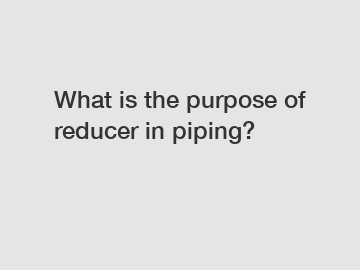Dec. 01, 2023
Mechanical Parts
What is the purpose of reducer in piping?
The reducer is a key component in piping systems that serves various purposes. In this article, we will delve into the significance of reducers and discuss their role in ensuring efficient and safe fluid flow. So, let's explore the importance of reducers in piping systems.
1. Managing Flow Rate: One of the primary purposes of a reducer is to manage and control the flow rate of fluids in the piping system. A reducer is designed to connect two pipes of different sizes, where one pipe diameter is larger than the other. By reducing the pipe diameter, the flow rate is regulated, ensuring optimal fluid velocity. Controlling the velocity helps prevent turbulence, pressure drops, and potential system failures.

2. Pressure Regulation: In addition to managing flow rate, reducers also play a crucial role in regulating pressure within the piping system. As fluids pass through the reducer, the reduced pipe diameter increases the velocity of the fluid stream. According to Bernoulli's principle, when fluid velocity increases, its pressure decreases. This pressure regulation is essential to ensure safe and efficient operation of the entire system.
3. Connecting Different Sized Pipes: In many instances, it is necessary to connect pipes of different sizes within a piping system. This connection can be achieved seamlessly with the use of a reducer. The larger end of the reducer connects to the larger diameter pipe, while the smaller end connects to the smaller diameter pipe. This transition prevents any abrupt changes in pipe size, allowing for smooth fluid flow and minimizing the risk of pipe blockages or turbulence.
4. Reducing Pipe Stress: Another significant purpose of using a reducer is to reduce stress on the piping system. When pipes of different sizes are joined directly, it can create uneven stress distribution, leading to potential failures and leaks. By incorporating a reducer, the transition between pipes is gradual, alleviating stress concentrations and promoting structural integrity. This reduces the risk of pipe failure, extending the overall lifespan of the piping system.
5. Facilitating System Maintenance: Piping systems often require maintenance, repairs, or modifications. A reducer simplifies this process by allowing for flexibility in system expansion or modification. Whenever changes need to be made, a reducer can be easily installed to connect the new pipe diameter to the existing system. This saves time, effort, and resources that would otherwise be required for more extensive alterations.
In conclusion, the purpose of a reducer in piping systems is multi-fold and essential for the efficient and safe transportation of fluids. By managing flow rates, regulating pressure, connecting different-sized pipes, reducing stress, and facilitating system maintenance, reducers contribute significantly to the overall performance and longevity of the piping system.
So, the next time you encounter a piping system, remember the importance of reducers and how they enable smooth and reliable fluid flow, ensuring the operation of various industries and applications.
For more information, please visit reducer pipe sizes, con. reducer, pipe reducer size.
If you are interested in sending in a Guest Blogger Submission,welcome to write for us!
All Comments ( 0 )